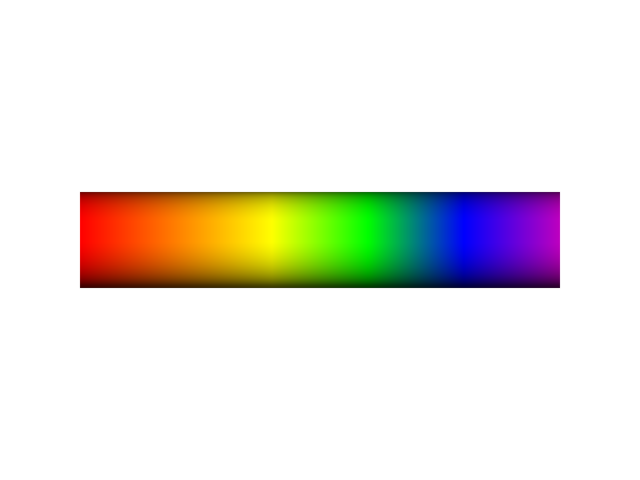Spectrumbar: Difference between revisions
No edit summary |
No edit summary |
||
| Line 15: | Line 15: | ||
Please see the script comments for further custom options. Once the script completes, it will generate a new object called "spectrumbar" (which can be changed through the options) which is a cylinder colored according to the user-specified colors. | Please see the script comments for further custom options. Once the script completes, it will generate a new object called "spectrumbar" (which can be changed through the options) which is a cylinder colored according to the user-specified colors. | ||
[[Image:sb_default.png]] | [[Image:sb_default.png|thumb 200px]] | ||
===EXAMPLES=== | ===EXAMPLES=== | ||
Revision as of 12:47, 3 September 2009
Description
Often times one may color their structure based upon some predefined color spectrum. However, this alone is not helpful when dealing with publication images. The purpose of this script is to allow the user to draw their own custom spectrum bar to accompany their structural images.
Further work will be done to improve the functionality of this script. Please feel free to contact the author for function requests.
USAGE
load the script using the run command
spectrumbar (RGB_Colors,radius=1.0,name=spectrumbar,head=(0.0,0.0,0.0),tail=(10.0,0.0,0.0),length=10.0)
Please see the script comments for further custom options. Once the script completes, it will generate a new object called "spectrumbar" (which can be changed through the options) which is a cylinder colored according to the user-specified colors.
EXAMPLES
Coming soon!
Script
load the script using the run command
from pymol.cgo import *
from math import *
from pymol import cmd
from re import *
def spectrumbar (*args, **kwargs):
"""
Author Sean Law
Michigan State University
slaw_(at)_msu_dot_edu
USAGE
While in PyMOL
run spectrumbar.py
spectrumbar (RGB_Colors,radius=1.0,name=spectrumbar,head=(0.0,0.0,0.0),tail=(10.0,0.0,0.0),length=10.0)
Parameter Preset Type Description
RGB_Colors [1.0,1.0,1.0] N/A RGB colors can be specified as a
triplet RGB value or as PyMOL
internal color name (i.e. red)
radius 1.0 float Radius of cylindrical spectrum bar
name spectrumbar string CGO object name for spectrum bar
head (0.0,0.0,0.0) float Starting coordinate for spectrum bar
tail (10.0,0.0,0.0) float Ending coordinate for spectrum bar
length 10.0 float Length of spectrum bar
Examples:
spectrumbar red, green, blue
spectrumbar 1.0,0.0,0.0, 0.0,1.0,0.0, 0.0,0.0,1.0
The above two examples produce the same spectrumbar!
spectrumbar radius=5.0
spectrumbar length=20.0
"""
rgb=[1.0, 1.0, 1.0]
name="spectrumbar"
radius=1.0
x1=0
y1=0
z1=0
x2=10
y2=0
z2=0
num=re.compile('[0-9]')
abc=re.compile('[a-z]')
for key in kwargs:
if (key == "radius"):
radius = float(kwargs["radius"])
print radius
elif (key == "name"):
name=kwargs["name"]
elif (key == "head"):
head=kwargs["head"]
head=head.strip('" []()')
x1,y1,z1=map(float,head.split(','))
elif (key == "tail"):
tail=kwargs["tail"]
tail=tail.strip('" []()')
x2,y2,z2=map(float,tail.split(','))
elif (key == "length"):
if (abc.search(kwargs["length"])):
print "Error: The length must be a value"
return
else:
x2=float(kwargs["length"]);
elif (key != "_self"):
print "Ignoring unknown option \""+key+"\""
else:
continue
args=list(args)
if (len(args)>=1):
rgb=[]
while (len(args)>=1):
if (num.search(args[0]) and abc.search(args[0])):
print "Error: RGB value \""+args[0]+"\" must either contain letters OR numbers"
return
elif (num.search(args[0])):
rgb.extend(args.pop(0))
else:
rgb.extend(cmd.get_color_tuple(args.pop(0)))
if (len(rgb) % 3):
print "Error: Missing RGB value"
print "Please double check RGB values"
return
dx=x2-x1
dy=y2-y1
dz=z2-z1
t=1.0/(len(rgb)/3.0-1)
c=len(rgb)/3-1
s=0
bar=[]
while (s < c):
if (len(rgb) >0):
r=rgb.pop(0)
g=rgb.pop(0)
b=rgb.pop(0)
bar.extend([CYLINDER])
bar.extend([x1+(s*t)*dx, y1+(s*t)*dy, z1+(s*t)*dz])
bar.extend([x1+(s+1)*t*dx, y1+(s+1)*t*dy, z1+(s+1)*t*dz])
bar.extend([radius, float(r), float(g), float(b)])
if (len(rgb) >= 3):
bar.extend([float(rgb[0]), float(rgb[1]), float(rgb[2])])
else:
bar.extend([float(r), float(g), float(b)])
s=s+1
cmd.delete(name)
cmd.load_cgo(bar,name)
return
cmd.extend("spectrumbar",spectrumbar)
